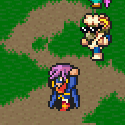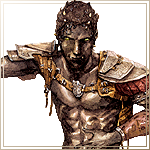 Add Review
Add Review Subscribe
Subscribe Nominate
Nominate Submit Media
Submit Media RSS
RSS
Good story! Got anything else?
 Merte
Merte- 02/25/2010 10:40 PM
- 2814 views
Along with a Blurred Line, Laxius Power, Phantasia and Alter A.I.L.A., this epic console style RPG is known by connoisseurs as one of the great “must have played” games crafted using Enterbrain’s RPG Maker 2000/2003 game creation software. The Way is in many ways an exceptional game, but does not come without its shortcomings. The game is split into six episodes, and this review will focus on episode one.
The introduction leaves the player rather puzzled, and this is clearly what the creator has aimed for. It is obvious that Crestfallen Studios has a vision of telling an intriguing story, and to tell it well.
You start out with little knowledge of who the hero is and where he is heading. You only know that he has a broken heart and that he is travelling along what is only referred to as the Way. A lost love is his motivation, a riddle is his character. The hero, Rhue by name, is pursued by an unknown shadow killer whose identity and intentions remain a mystery. Rhue encounters a few interesting characters along the road, with stories to tell and secrets to keep. People are seldom who they appear to be.
Writing good characters is perhaps one of the biggest challenges for anyone who wants to tell a story through a video game. It is debatable whether the video game is an ideal medium if the purpose is to tell a story, rather than simple entertainment (perhaps the basics are, after all, what video games do best). However, many of my fondest memories were video games that were also storytellers, so the question might rather be what sort of player the game is aiming for; who the target audience is. In other words: players, who would never open a book that is not in the curriculum, should keep away. However, if that was the case, you would probably have stopped reading this review by now.
Visually, The Way is a very mixed experience. That does by no means mean that any of the graphics are bad, it simply means that they are very mixed.
This game comes with background graphics that simply look strange. Some areas are created using what most people would recognise as a tile-based method (like a jigsaw puzzle with different graphics put together) used in most 16-bit RPGs from the early 90s. While quite a lot of areas are made up by odd, blurry, pre-rendered backgrounds that do not fit in with the sprites at all. The switching between pre-rendered backgrounds and tile based backgrounds makes this oddity even more significant. This issue is of course debatable, since surely some readers will disagree with me, but personally I found this whole package odd and out of place. Some of the rather gaudy game interface also has a bit of an amateurish feel to them. I miss a more elegant touch to the game’s visual design. The blood and gore, however, looks excellent.
When it comes to presentation, we are trotting into an area where The Way passes with flying colours. The Way (no pun intended) scenes are directed, the very narrative capability possessed by the game’s creator, is absolutely brilliant. Especially one scene, where two children were chased by wolves, was very rewarding. The main theme is simply beautiful, the kind of tune that you will probably whistle on your way to work, and the overall use of soundscapes is excellent. I do not doubt for a second that the game creator would have made a fine film director.
The story is very well structured and always makes sure to let go of just enough to keep the player interested. The first episode ends with a nice cliff-hanger, which simply makes you gasp for more. The pen is strong with this one.
The Way is more than a story; it is also an interactive experience. The gameplay focuses on four major building blocks: puzzles, minigames, combat, and “plunges”. Both combat and plunges can be disabled if the player wishes it, and puzzles can be skipped. The combat is very traditional, although perhaps a bit shallow. “Plunges” is like an additional battle system that makes the player engage in duels with NPCs structured like a game of rock, paper and scissors. This is a nice effort, although the outcome of different attacks does feel a bit random. The interface and modifiers that come with the battle systems are a bit confusing, and even though all aspects of the game come with tutorials, fiddling with them by myself afterwards often gave me a feeling of not having the slightest idea of what I was doing. Altogether, neither of the battle systems stand on solid ground on their own, nor do they complement each other. Plunges feel random and uncontrolled, and combat is just a very slow and very repetitive experience.
It cannot be stressed enough that this game does require patience. It requires concentration, and it requires a predetermined love for the genre. This is not the game that will make you love console style RPGs if you are not already a fan.
I would like to point out two reasons for this: First of all, The Way suffers from a lack of choice. This is common in linear console style RPGs, but this game is literally a predetermined path that does not allow the player to contribute even a little to the progression or the direction that the game takes. There are a few dialog choices to be made, but these are seemingly without any impact on the game. At least I would like to think that I chose to go into that cave to kill that monster.
Secondly, there is the lack of goals and motivation. The story is well told, but the player has little motivation to continue the journey. It is simply a journey, and there is no goal. The hero is just travelling, but to no particular place. It is just “along the Way” with a vague motivation to find a lost love. Along the journey different things just seem to happen randomly, creating obstacles that have to be overcome. Since the psychology of video games heavily rely on behaviouristic principles (1. motivation, 2. task and 3. reward by success), it is a good idea for any game designer of any genre to keep this in mind. Should I go into that cave because the game tells me to, or should I go into that cave because there is an artefact hidden in there? Although it might sound trite, it is not necessarily a bad idea to put out items for the player to collect. Most players require something more than just a nice story and interesting characters to motivate them, and the ability to find or purchase new pieces of armour usually feels rewarding.
As a whole, The Way is a pleasant gaming experience that does not come without shortcomings in its gameplay and visual style. However, with compelling storytelling and interesting characters, this is not a piece of interactive entertainment you would like to miss. If you play games for their story, The Way is definitely a game you will enjoy. And for an introductory episode it is a very good start. Let us just hope that the next five episodes manage to pull together all the loose ends.
The introduction leaves the player rather puzzled, and this is clearly what the creator has aimed for. It is obvious that Crestfallen Studios has a vision of telling an intriguing story, and to tell it well.
You start out with little knowledge of who the hero is and where he is heading. You only know that he has a broken heart and that he is travelling along what is only referred to as the Way. A lost love is his motivation, a riddle is his character. The hero, Rhue by name, is pursued by an unknown shadow killer whose identity and intentions remain a mystery. Rhue encounters a few interesting characters along the road, with stories to tell and secrets to keep. People are seldom who they appear to be.
Writing good characters is perhaps one of the biggest challenges for anyone who wants to tell a story through a video game. It is debatable whether the video game is an ideal medium if the purpose is to tell a story, rather than simple entertainment (perhaps the basics are, after all, what video games do best). However, many of my fondest memories were video games that were also storytellers, so the question might rather be what sort of player the game is aiming for; who the target audience is. In other words: players, who would never open a book that is not in the curriculum, should keep away. However, if that was the case, you would probably have stopped reading this review by now.
Visually, The Way is a very mixed experience. That does by no means mean that any of the graphics are bad, it simply means that they are very mixed.
This game comes with background graphics that simply look strange. Some areas are created using what most people would recognise as a tile-based method (like a jigsaw puzzle with different graphics put together) used in most 16-bit RPGs from the early 90s. While quite a lot of areas are made up by odd, blurry, pre-rendered backgrounds that do not fit in with the sprites at all. The switching between pre-rendered backgrounds and tile based backgrounds makes this oddity even more significant. This issue is of course debatable, since surely some readers will disagree with me, but personally I found this whole package odd and out of place. Some of the rather gaudy game interface also has a bit of an amateurish feel to them. I miss a more elegant touch to the game’s visual design. The blood and gore, however, looks excellent.
When it comes to presentation, we are trotting into an area where The Way passes with flying colours. The Way (no pun intended) scenes are directed, the very narrative capability possessed by the game’s creator, is absolutely brilliant. Especially one scene, where two children were chased by wolves, was very rewarding. The main theme is simply beautiful, the kind of tune that you will probably whistle on your way to work, and the overall use of soundscapes is excellent. I do not doubt for a second that the game creator would have made a fine film director.
The story is very well structured and always makes sure to let go of just enough to keep the player interested. The first episode ends with a nice cliff-hanger, which simply makes you gasp for more. The pen is strong with this one.
The Way is more than a story; it is also an interactive experience. The gameplay focuses on four major building blocks: puzzles, minigames, combat, and “plunges”. Both combat and plunges can be disabled if the player wishes it, and puzzles can be skipped. The combat is very traditional, although perhaps a bit shallow. “Plunges” is like an additional battle system that makes the player engage in duels with NPCs structured like a game of rock, paper and scissors. This is a nice effort, although the outcome of different attacks does feel a bit random. The interface and modifiers that come with the battle systems are a bit confusing, and even though all aspects of the game come with tutorials, fiddling with them by myself afterwards often gave me a feeling of not having the slightest idea of what I was doing. Altogether, neither of the battle systems stand on solid ground on their own, nor do they complement each other. Plunges feel random and uncontrolled, and combat is just a very slow and very repetitive experience.
It cannot be stressed enough that this game does require patience. It requires concentration, and it requires a predetermined love for the genre. This is not the game that will make you love console style RPGs if you are not already a fan.
I would like to point out two reasons for this: First of all, The Way suffers from a lack of choice. This is common in linear console style RPGs, but this game is literally a predetermined path that does not allow the player to contribute even a little to the progression or the direction that the game takes. There are a few dialog choices to be made, but these are seemingly without any impact on the game. At least I would like to think that I chose to go into that cave to kill that monster.
Secondly, there is the lack of goals and motivation. The story is well told, but the player has little motivation to continue the journey. It is simply a journey, and there is no goal. The hero is just travelling, but to no particular place. It is just “along the Way” with a vague motivation to find a lost love. Along the journey different things just seem to happen randomly, creating obstacles that have to be overcome. Since the psychology of video games heavily rely on behaviouristic principles (1. motivation, 2. task and 3. reward by success), it is a good idea for any game designer of any genre to keep this in mind. Should I go into that cave because the game tells me to, or should I go into that cave because there is an artefact hidden in there? Although it might sound trite, it is not necessarily a bad idea to put out items for the player to collect. Most players require something more than just a nice story and interesting characters to motivate them, and the ability to find or purchase new pieces of armour usually feels rewarding.
As a whole, The Way is a pleasant gaming experience that does not come without shortcomings in its gameplay and visual style. However, with compelling storytelling and interesting characters, this is not a piece of interactive entertainment you would like to miss. If you play games for their story, The Way is definitely a game you will enjoy. And for an introductory episode it is a very good start. Let us just hope that the next five episodes manage to pull together all the loose ends.

Posts 

Pages:
1
I like your review, but I get the feeling that something bothered you about this game, but it was not clear what.
Corfaisus


"It's frustrating because - as much as Corf is otherwise an irredeemable person - his 2k/3 mapping is on point." ~ psy_wombats
7874
Wait... there was a storyline?
Well, the main thing that bothered me, is the fact that the game does a great job at storytelling, but doesn't seem to understand that the the story on its own doesn't make a game.
I enjoyed your review and I very much look forward to your take on the rest of the episodes. I'm surprised you took so much out of Ep.1, which is easily the weakest of the series. The story only becomes more interesting from here. I will say this, if you are expecting all questions to be answered by the end, you will be disappointed.
Pages:
1














